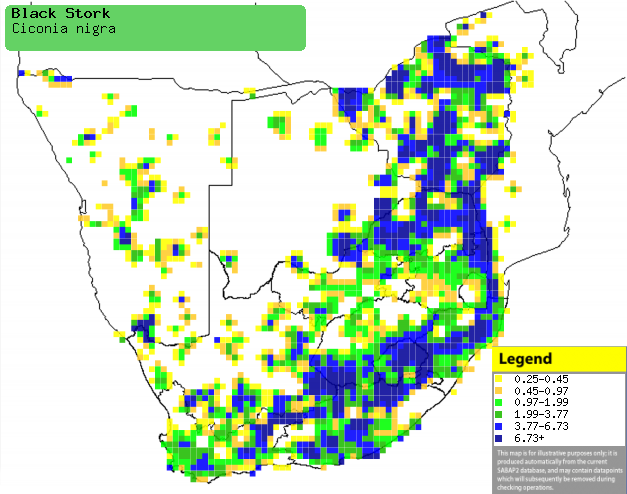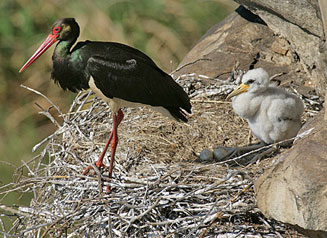|
Ciconia nigra (Black stork)
Grootswartooievaar [Afrikaans]; Unocofu [Xhosa];
Endongondongo (generic term for dark-coloured storks) [Kwangali]; Mokoroane
(also applied to White stork) [South Sotho]; Zwarte ooievaar [Dutch]; Cigogne
noire [French]; Schwarzstorch [German]; Cegonha-preta [Portuguese]
Life
> Eukaryotes >
Opisthokonta
> Metazoa (animals) >
Bilateria >
Deuterostomia > Chordata >
Craniata > Vertebrata (vertebrates) > Gnathostomata (jawed
vertebrates) > Teleostomi (teleost fish) > Osteichthyes (bony fish) > Class:
Sarcopterygii (lobe-finned
fish) > Stegocephalia (terrestrial
vertebrates) > Tetrapoda
(four-legged vertebrates) > Reptiliomorpha > Amniota >
Reptilia (reptiles) >
Romeriida > Diapsida > Archosauromorpha > Archosauria >
Dinosauria
(dinosaurs) > Saurischia > Theropoda (bipedal predatory dinosaurs) >
Coelurosauria > Maniraptora > Aves
(birds) > Order: Ciconiiformes
> Family: Ciconiidae
Distribution and habitat
Breeds from Japan and north-eastern China to western Europe
and Denmark, heading south in the non-breeding season to northern India, eastern
China and equatorial Africa. There is a separate resident population in Zambia,
Angola and southern Africa, bordering on Mozambique and Botswana. It can occupy almost any type of wetland, such as pans,
rivers, flood plains, ponds, lagoons, dams, swamp forests, mangrove swamps,
estuaries, tidal mudflats and patches of short grass close to water.
|
 |
|
Distribution of Black stork in southern Africa,
based on statistical smoothing of the records from first SA Bird Atlas
Project (©
Animal Demography unit, University of
Cape Town; smoothing by Birgit Erni and Francesca Little). Colours range
from dark blue (most common) through to yellow (least common).
See here for the latest distribution
from the SABAP2. |
Predators and parasites
- Predators of eggs and nestlings
Movements and migrations
Resident and locally nomadic, moving in search
of high-quality foraging habitats such as pools and estuaries.
Food
It mainly eats fish, doing most of its foraging by wading
through shallow water, stabbing at prey. The following food items have been
recorded in its diet:
- Vertebrates
- fish
- Clarias (catfish)
- Clarias gariepinus (Sharptooth catfish)
- Labeo (mudfishes)
- Hydrocynus vittatus (Tigerfish)
- Oreochromis mossambicus (Mozambique tilapia)
- Cyprinus carpio (Carp)
- Barbus anoplus (Chubbyhead barb)
- amphibians
- Xenopus laevis (Common platanna)
- Bufo vertebalis (Pygmy toad)
- Tomopterna delalandi (Cape sand frog)
- bird nestlings
- tortoises
- Invertebrates
- insects
- Spodoptera exempta (Armyworms)
- freshwater snails
Breeding
- Monogamous solitary nester, possibly with a life-long pair bond, sometimes
sharing the nest cliff with birds of prey, such as
Cape vulture,
Verreauxs' eagle,
Peregrine falcon and
Lanner falcon.
- The nest is built and repaired by both sexes, consisting of a fairly flat
platform of dry reeds, sticks and other dry plant matter, with a shallow
central bowl lined with grass and other soft material. It is typically
placed on a cliff ledge, pothole or cave, sometimes on top of the old nest
of a Hamerkop,
Verreauxs' eagle or
African harrier-hawk.
 |
|
|
Black stork at nest with chick, Vaalwater area,
South Africa. [photo
Warwick Tarboton ©] |
|
- Egg-laying season is from April-September, peaking from May-August.
- It lays 2-5 eggs, which are incubated by both sexes for about 35-36
days.
- The chicks are brooded almost continually for the first 15 days or so of
their lives
and are fed by both parents. They leave the nest at about 63-71 days old,
becoming fully independent roughly two weeks later.
Threats
Not threatened globally, although considered to be locally
Near-threatened in South Africa and Endangered in Namibia.
References
-
Hockey PAR, Dean WRJ and Ryan PG 2005. Roberts - Birds of
southern Africa, VIIth ed. The Trustees of the John Voelcker Bird Book
Fund, Cape Town.
|
